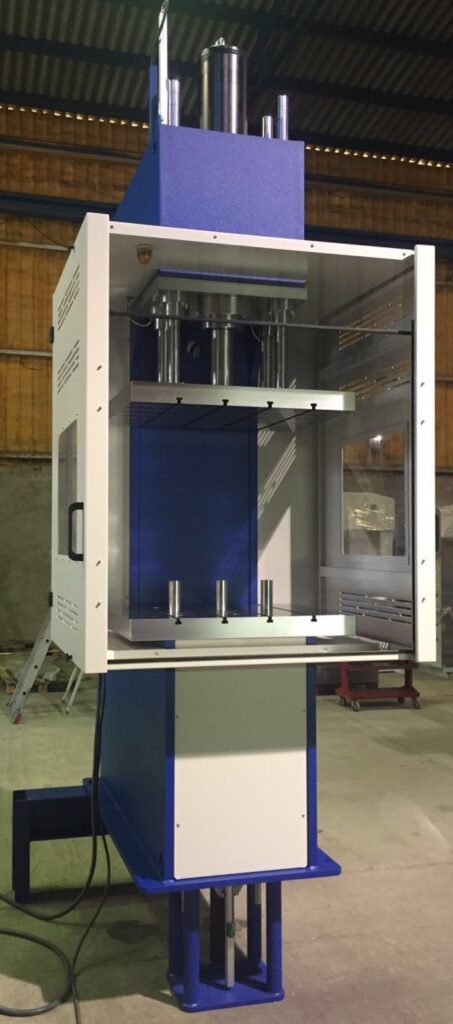Back in October 2016 an article about our custom-made presses was published in Metaalnieuws (which can be read in Dutch on their website). We delivered these C-frame presses in April of that year. To this day, we still bring potential customers to the company that has purchased these customized C-frame presses to give them a demonstration. That is the reason why we want to fresh up our memories again and translate the article for the non-Dutch visitors of our website. So, here it goes.
The article
The two 80-ton hydraulic custom-made presses that RHTC delivered to Pull Rhenen are a good example of the strength of their company. RHTC not only supplies high-quality presses, but they can also be custom-made in a close interaction between manufacturer, supplier and end-user. The customer – in this case Pull Rhenen – is reaping the benefits: the quality of the products being pressed has been improved and the outages have been reduced.
Rob and Tim Huberts did not think that a company like Pull Rhenen would ever belong to their clientele. Because Pull Rhenen has nothing to do with metalworking and RHTC is mainly focused on that. But Rob Huberts knows that pressing takes place everywhere, so even at companies that do not machine metal.
Insulation products
Pull Rhenen specializes in insulation products for the industrial sector and cultivation solutions for the agricultural sector. The minerals perlite and vermiculite form the basic raw materials that are processed by Pull Rhenen into customer-specific semi-finished and end products. The agricultural sector uses these, for example, as sowing material and to improve potting soil. The (construction) industry uses the specialized fire-resistant, sound and thermally insulating products from Pull Rhenen to realize safe and responsible structures.
Vermiculite arrives in large quantities at Pull Rhenen. There it is heated, which produces fine light brown grains. They are pressed into various products to, for example, serve as insulation material in ovens, in aluminum pots and in the walls of ships. Presses are therefore an important part of the machine park. “We have approximately eight presses, including a large, self-developed 4-column press for pressing large plates,” says Hanje van Stuivenberg, operations manager at Pull Rhenen.
More press capacity
Investments have been made in two new C-frame presses. That had several reasons. The existing presses can press a maximum of 20 to 25 tons. “We wanted to expand that capacity with a larger tonnage,” says Van Stuivenberg. “Nowadays the customer demands a higher density of the products, because they insulate even better. For that you need more pressing power. We also wanted a press that could press both above and below. “
Looking for presses of West European quality, he visited the website of press supplier RHTC. Van Stuivenberg was mainly attracted by the robustness of the machines. “The top of the presses, for example, have coarse, sturdy guides. We went to see one of the presses and were sold immediately. They are beautiful, reliable machines. Moreover, they are compact, which is not unimportant given our space.”
But Pull Rhenen had some extra requirements. A standard press that only makes simple strokes up and down is not enough to press vermiculite. This is a precise and sensitive job. For the most part it is manual work. The molds are filled manually with the material. The man who operates the machine knows exactly where to press or remove something, so that the hardness is good and that no breaks occur in the pressed product. The pressing process itself is quite complex and requires not only a very stable top and bottom plate, but also many options for precisely controlling the process. Permanence times and accessories were also requirements for the custom-made presses.
Good cooperation
That is why the two presses are made customer-specific, whereby Pull Rhenen was involved in the design. Van Stuivenberg is very happy with that. “Our experience is that you often encounter resistance from machine builders if you want to change something mechanically, hydraulically or technically. That was not the case here. Communication with RHTC and the factory was quick and smooth. We received good drawings, had no discussion at all about the software and were able to make the desired adjustments. The hydraulics had already been set for this in advance. “
A striking modification is that the lower stamp is provided with several guides and injectors. This is important because the upper and lower stamps must be attached at a certain height in order to press precisely with the right force and at the right moment. The guides and injectors in the lower stamp prevent instability during the process.
Less aftertreatment
Both presses work very well. The production speed has remained the same, but the quality of the products has improved and the down time is clearly reduced. The pressing procedure with the C-frame presses results in the desired higher density and less after-treatment. “We only need to remove the burrs from the products, but they are inevitable,” says Van Stuivenberg. “This is an excellent investment for us.”
